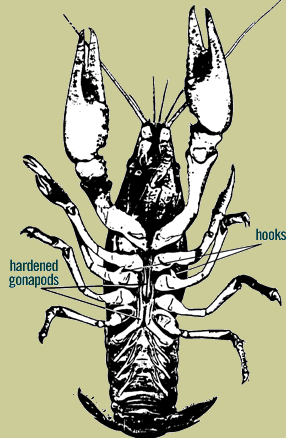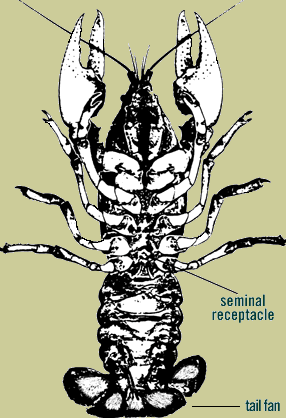
rusty crayfish factsheet
by Jeffrey Gunderson
Rusty crayfish (Orconectes rusticus) have invaded portions of Minnesota, Wisconsin,
Ontario, and many other areas. Although native to parts of some Great Lakes states, rusty
crayfish have spread to many northern lakes and streams where they cause a variety of
ecological problems.
Rusty crayfish were probably spread by non-resident anglers who brought them north to use as
fishing bait. As rusty crayfish populations increased, they were harvested for the regional
bait market and for biological supply companies.
Rusty crayfish inhabit lakes,
ponds, and streams. They prefer areas that offer rocks, logs, or other debris
as cover. Bottom types may be clay, silt, sand, gravel, or rock. Rusty crayfish
inhabit both pools and fast water areas of streams. They generally do not dig
burrows other than small pockets under rocks and other debris, although there
have been reports of more substantial burrows. Unlike some species (such as the
papershell crayfish, O. immunis) which dig burrows to escape ponds that
are drying up or becoming inhospitable, rusty crayfish need permanent lakes or
streams that provide suitable water quality year-round.
Mature rusty crayfish mate in late summer,
early fall, or early spring. The male transfers sperm to the female ,
which she then stores until her eggs are ready to fertilize, typically
in the spring (late April or May) as water temperatures begin to increase. The
stored sperm are released as eggs are expelled and external fertilization occurs.
The eggs are then attached to the swimmerets on the underside of the crayfish's
abdomen ("tail section"). Just prior to egg laying, white patches appear on the
underside of the abdomen ("tail section"), especially on the tail fan (Figure
3). These white patches are glair, a mucus-like substance secreted during egg
fertilization and attachment. Rusty crayfish females lay from 80 to 575 eggs.
Left above:
The underside
of a Form I male crayfish showing one pair of legs with hooks (copulatory stylets)
and hardened gonapods.
Growth slows considerably after crayfish reach maturity. While mature
males molt twice per year, females usually only molt once. Females molt after
the release of their young, typically in June or early July. In the spring, males
will molt into a sexually-inactive form (called Form II) and then molt back into
the reproductively-competent form (Form I) in summer. Form I males are characterized
by large claws, a hook on one pair of their legs (Figure 2), and hardened gonapods.
The hook and the larger claws are used for grasping females during mating. Because
males have an additional molt each year, they are usually larger than females
of the same age. A typical rusty crayfish lives three to four years.
Crayfish are considered opportunistic feeders. Rusty crayfish feed
on a variety of aquatic plants, benthic invertebrates (like aquatic worms, snails,
leeches, clams, aquatic insects, and crustaceans like side-swimmers and waterfleas),
detritus (decaying plants and animals including associated bacteria and fungi),
fish eggs, and small fish.
Left below:
The underside of a female crayfish showing the seminal receptacle where the
sperm capsule is held by the female until eggs are fertilized.
 Eggs
hatch in three to six weeks, depending on water temperature. Once hatched, young
crayfish cling to the female's swimmerets for three to four molts (molting is
when crayfish shed their old shell to allow growth). Young crayfish may stay with
the female for several weeks. She offers them protection during this vulnerable
life stage. Eventually, the young leave the female. They undergo eight to ten
molts before they mature, which may occur during the first year, but more likely
the following year. Rusty crayfish reach maturity at a total length of one and
three-eighths inches and reach a maximum length of about four inches (not including
claws). They averaged two and one-half inches in Wisconsin collections (Hobbs
and Jass 1988).
Eggs
hatch in three to six weeks, depending on water temperature. Once hatched, young
crayfish cling to the female's swimmerets for three to four molts (molting is
when crayfish shed their old shell to allow growth). Young crayfish may stay with
the female for several weeks. She offers them protection during this vulnerable
life stage. Eventually, the young leave the female. They undergo eight to ten
molts before they mature, which may occur during the first year, but more likely
the following year. Rusty crayfish reach maturity at a total length of one and
three-eighths inches and reach a maximum length of about four inches (not including
claws). They averaged two and one-half inches in Wisconsin collections (Hobbs
and Jass 1988).
| minnesota sea grant |